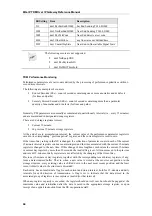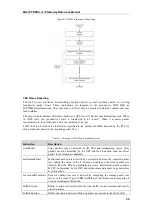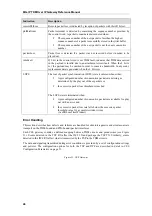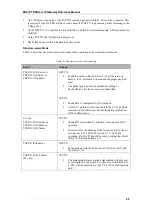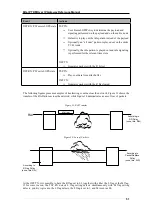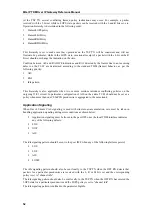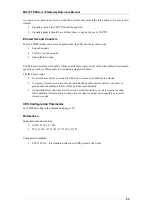
MG-IP TDM Over IP Gateway Reference Manual
39
OOF (Out-Of-Frame) Defect
This defect occurs whenever errors in the incoming framing pattern are discovered. This can occur
when 2 of 4, 2 of 5, or 3 of 5 framing bits are in error. A reframe clears the OOF defect. OOF is not
declared when AIS is present.
For T1 links, an Out of Frame defect is declared when the receiver detects two or more framing errors
within a 3 ms period for ESF signals and within a 0.75 ms period for D4 signals, or two or more errors
out of five or fewer consecutive framing-bits.
For E1 links, an Out Of Frame defect is declared when three consecutive frame alignment signals have
been received with an error.
Once an Out Of Frame Defect is declared, the framer starts searching for a correct framing pattern. The
Out of Frame defect ends when the signal is in frame.
In-frame occurs when there are fewer than two frame bit errors within a 3 ms period for ESF signals
and within a 0.75 ms period for D4 signals.
For E1 links, the Out of Frame defect is cleared when:
In frame N, the frame alignment signal is correct, and
in frame N+1, the frame alignment signal is absent (i.e., bit 2 in TS0 is a one), and
in frame N+2, the frame alignment signal is present and correct
LOS Defect (Line Defect)
A LOS (Loss Of Signal) defect is declared when no pulses have been detected during a defined period
of time, as follows:
For DS1, the Loss Of Signal defect is declared upon observation of 175 +/- 75 contiguous
pulse positions with no pulses of either positive or negative polarity. The LOS failure is
cleared upon observation of an average pulse density of at least 12.5% over a period of 175
+/- 75 contiguous pulse positions, starting with the receipt of a pulse.
For E1 links, the Loss Of Signal failure is declared when 255 consecutive zeroes are detected
(E1RCR2.RCLA= 0)
RDI Defect
While ANSI T1.231.02-2003 does not define the RDI defect and defines only the RAI failure,
ITU-T G.0775 and G.0705 distinguish between the RDI defect and RAI failure. RAI definitions will be
made using the ITU-T terminology so that the final behavior of the system will comply with both ANSI
T1.231.02-2003 and G.0705/G.0775.
RDI defect for T1 lines
- RDI definitions for DS1 lines are adopted from ANSI T1.231.02-
2003, 9.1. For DS1 links, RDI defect is declared as soon as a DS1 terminal determines that it
is receiving an RAI signal from the Far-End. The RDI defect is cleared as soon as the DS1
terminal determines that it is no longer receiving an RAI signal from the Far-End
For T1 SF (D4) links, the RAI signal is sent by setting bit 2 of all DS0 channels to "0" for the
entire duration (and at least for 1 second) of an LOS, LOF or AIS failure
For T1 ESF links, the RAI signal is sent by a repeating 16-bit pattern consisting of eight
"ones" followed by eight "zeroes" for the entire duration (and at least for 1 second) of an LOS,
LOF or AIS failure
RDI defect for E1 lines - RDI definitions for E1 lines are taken from G.0775, 6.1 and 6.2
For E1 links carrying basic frame structures, a Remote Defect Indication (RDI) defect at 2048
kbit/s path termination functions is detected when the incoming signal has the "Remote alarm
indication" bit set to binary ONE ("1") for z consecutive double frame periods,
where z = 2 .. 5 and is not provisionable




















